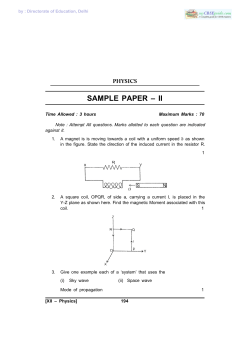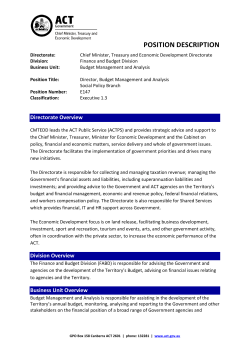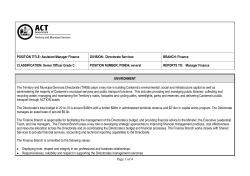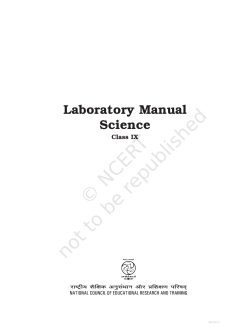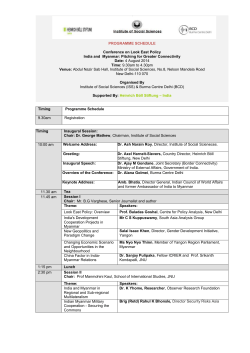
SAMPLE QUESTION PAPER-I Chemistry (Theory)
by : Directorate of Education, Delhi SAMPLE QUESTION PAPER-I Chemistry (Theory) Time : 3 hours Total Marks : 70 General Instruction (i) All questions are compulsory. (ii) Question number 1 to 8 are very short answer questions, carrying 1 mark each. Answer these in one word or about one sentence each. (iii) Question number 9 to 18 are short answer questions, carrying 2 marks each. Answer these in about 30 words each. (iv) Question number 19 to 27 are short answer questions, carrying 3 marks each. Answer these in about 40 words each. (v) Question number 28 to 30 are long answer questions, carrying 5 marks each. Answer these in about 70 words each. (vi) Use log table, if necessary. (vii) Use of calculator is not permitted. 1. A and B liquids on mixing produce a cold solution. Which type of deviation from Raoult’s law is shown by solution? 2. Name the shape-selective catalyst used to convert alcohols directly into gasoline. 3. What is the role of cryolite in the metallurgy of aluminum? 4. W rite the IU P A C nam e of [C o(N H 3)5(SO4)]Br. 5. How will you distinguish between phenol and cyclohexanol by suitable chemical test? 6. Draw the strcture of Hex-2-enoic acid. 7. Write the IUPAC name of the organic compound: CH3 CH3CH2CH2 N CH2CH3 8. Name the animal starch which is broken down by enzymes to glucose when body needs it. 207 Twinklegraphics*chemistry-XII*2013-addition QP-1*3rd print [XII – Chemistry] by : Directorate of Education, Delhi 9. A metal has a body centred cubic crystal lattice. The density of the metal is 5.91 g cm-3. Find out the volume of the unit cell.. [Given: Molar mass of metal = 50.0 g mol-1 and NA= 6.023 × 1023 mol-1] 10. Account the following: (a) Frenkel defect is observed in silver halides. (b) Schottky defect lowers the density of the crystal. 11. A 0.2% aqueous solution of a non-volatile solufe exerts a vapour pressure of 1.004 bar at 100°C. What is the molar mass of the solute? 12. Assuming complete ionisation, calculate the freezing point of solution prepared by dissolving 6.0 g of Glauber’s salt, Na2SO4.10H2O.(Molar mass = 322g mol-1) in 0.1 kg of H2O. [Given Kf for water = 1.86 K kg mol-1] 13. List two difrferences between order of reaction and molecularity of reaction. 14. Outline the principle of refining of metals by the following methods: (a) Zone refining (b) Electrolytic refining OR How is copper extracted from copper pyrities? Write the equations of the reactions involved. 15. Draw the structures of the following molecules. (a) XeF2 (b) ClF3 16. Explain on the basis of VBT that diamagnetic [Ni(CN)4]2- is square planar. 17. Identify the compounds A, B, C and D is the following sequence of reactions: CH3 CH CH2 CH3 Alc. KOH A Br 2 B (i) Alc. KOH (ii) NaNH2 C H2 O 2+ Hg /H2SO4 D Br 18. Give reasons for the following: (a) t-Butyl bromide has lower boiling point than n-butyl bromide. 208 Twinklegraphics*chemistry-XII*2013-addition QP-1*3rd print [XII – Chemistry] by : Directorate of Education, Delhi (b) The dipole moment of chlorobenzene is lower than that of cyclohexyl chloride. 19. The rate of a reaction quadruples when the termperature changes from 293 K to 313 K. Calculate the energy of activiation of the reaction asuming that it does not change with temperature. (R = 8.314 J mol–1 k–1). 20. Explain what happens, when: 21. 22. 23. (a) KCI, an electrolyte is added to hydrated ferric oxide solution. (b) An electric current is passed through a colloidal solution. (c) A beam of light is passed through a colloidal solution. Complete the following equations: (a) Cl2 NaOH Hot & conc. (b) KI O3 H2O (c) XeF4 H2 O Arrange the following in order of the property mentioned against each: (a) PH3, NH3, SbH3, AsH3 (Increasing basic strength) (b) H2O, H2S, H2Se, H2Te (Increasing bond angle) (c) HClO4, HClO3, HClO2, HClO (Increasing oxisidsing ability) PHBV (Poly--hydroxybutyrate-CO-hydroxyvalerate) is biodegradable polymer. It is a co-polymer of 3-hydroxybutanoic acid and 3-hydroxypentanoic acid. (a) How PHBV has found utility in medicines as capsule? (b) Write the name of polymer used in artificial limb popularly known as jaipur foot. (c) Write the values associated with the use of PHBV. OR Write the monomers of following polymers and mention one use of each polymer. 209 Twinklegraphics*chemistry-XII*2013-addition QP-1*3rd print [XII – Chemistry] by : Directorate of Education, Delhi 24. (a) PAN (b) Nylon-6,6 (c) Glyptal Give the pharmacological functions of the following type of drugs: (a) Analgesics 25. (a) HI (ii) Acetic anhydride (b The glucose is correctly named as D-(+)- glocuse. What are reqpresented by the letter ‘D’ and sign (+)? (a) Give a chemical test to distinguish between the following pairs of compounds: NH2 and (b) 28. CH2 NH2 Illustrate the following with an example of reaction in each case: (i) 27 (c) Antifertility drugs W hat happens when D-glucose is treated with the following reagents?Write chemical equations of the reactions involved. (i) 26. (b) Tranquilizers Sandmeyer reaction (ii) Coupling reaction of phenol with aniline (a) How are the following conversions carried out? (i) Ethanol to propan-2-ol (ii) Phenol to acetophenone (b) Explain why 4-nitrophenol is more acidic than 4-methoxyphenol? (a) Write the mechanism of corrosion. Explain why galvanised iron does not rust even if the coating of zinc is broken. (b) Consider the cell: Mg s Mg2 1 102 M Ag 1 104 M Ag(s) Its Ecell is 2.96 V.Calculate E0celland r G for the cell reaction. 210 Twinklegraphics*chemistry-XII*2013-addition QP-1*3rd print [XII – Chemistry] by : Directorate of Education, Delhi [Given : R = 8.314 JK-1 mol-1, and F= 96500 C mol-1] OR (a) Explain Kohlrausch’s law of independent migration of ions. Why does the conductivity of any electrolyte decreases with dilution? (b) Predict the products of electrolysis in each of the folloiwng: (i) An aqueous solution of AgNO3 with silver electrodes. (ii) An aqueous solution of AgNO3 with plantinum electrodes. (iii) A dilute solution of H2SO4 with platinum electrodes. 0 0 0 [Given : EO2 /H2O 1.23V, E Ag / Ag 0.80V, EH2O /H2 0.83V ] 29. (a) Indicate the steps involved in the preparation of K2Cr2O3 from chromite ore. Write chemical equations of ractions involved. (b) Account for the following: (i) Copper is regarded transition metal although in has 3d10 configuration. (ii) Transition metal ions are coloured in water. (iii) On moving down Zr to Hf in group 4, it is observed that their atomic and ionic radii are almost the same. OR (a) Indicate the steps involved in the preparation of KMnO4 from pyrolusite ore. Write chemical equations of the reactions involved. (b) account for the following: (i) K2Cr2O7 is preferred over Na 2Cr2O7 in volumetric analysis though both are oxiding agents. (ii) The actinoids exhibits a greater range of oxidation states as compared to lanthanoids. (iii) Antinoid contraction from element to element is greater than lanthanoid contraction. 211 Twinklegraphics*chemistry-XII*2013-addition QP-1*3rd print [XII – Chemistry] by : Directorate of Education, Delhi 30. (a) Write structural formulae and names of four possible aldol condensation products obtained from propanal and ethanal. Indicate which aldeyde acts as nucleophile and which as electrophile. (b) Give reasons for the following: (c) (i) Carboxylic acids do not give characteristic reactions of carbonyl group. (ii) Aldehydes are more reactive than ketones towards nucleophiles. Completye the following reaction statements by giving the missing starting material, reagent or product as required:: (i) (ii) ? O3 Zn – H2O O + HCHO CH3 COCH2COOC 2H5 (i) NaBH4 + (ii) H3O CH2OH (iii) (d) KMnO4 KOH, heat Write one chemical equation for each to illustrate the folloiwng reactions: (i) Hell-Volhard-Zelinsky reaction (ii) Cannizzaro reaction 212 Twinklegraphics*chemistry-XII*2013-addition QP-1*3rd print [XII – Chemistry]
© Copyright 2025




